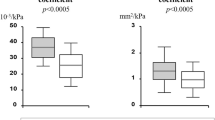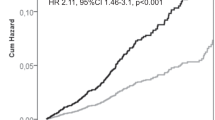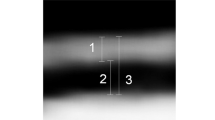Abstract
Few data have been published about the relation between the vessels geometry and development of left ventricular (LV) hypertrophy in patients with arterial hypertension. The aim of this study is to describe arterial and LV geometry changes due to mild-to-moderate arterial hypertension in an untreated hypertensive population.In 95 untreated patients with mild-to-moderate hypertension and 23 age- and sex-matched healthy normotensives, we measured the end-diastolic diameter and wall thickness of the left ventricle and the internal diameter and intimal-medial thickness (IMT) of carotid and brachial arteries. From these data, the cross-sectional areas (CSAs) of arterial and myocardial walls were calculated. Hypertensive patients were further subdivided on the basis of the presence of LV hypertrophy defined according to Devereux et al as anatomical LV mass >125 g/m. In hypertensive patients with hypertrophy, carotid and brachial CSAs increased, without significant changes in thickness/diameter ratio (arterial ‘enlargement’), while the left ventricle developed ‘concentric’ hypertrophy. Arterial and LV CSAs showed a significant direct correlation with systolic blood pressure (BP). However, when data were corrected for BP, the correlation between the increase in arterial and LV CSAs became much improved than for the raw data.In conclusion patients with untreated mild-to-moderate hypertension, both carotid and brachial arterial walls showed an enlargement that was proportional to the development of LV hypertrophy. These results suggest that the effects of arterial hypertension on carotid, brachial and LV wall geometry have a common modulation.
This is a preview of subscription content, access via your institution
Access options
Subscribe to this journal
Receive 12 digital issues and online access to articles
$119.00 per year
only $9.92 per issue
Buy this article
- Purchase on Springer Link
- Instant access to full article PDF
Prices may be subject to local taxes which are calculated during checkout
Similar content being viewed by others
Author information
Authors and Affiliations
Rights and permissions
About this article
Cite this article
Fantini, F., Barletta, G., Bene, R. et al. Parallel increase in carotid, brachial and left ventricular cross-sectional areas in arterial hypertension. J Hum Hypertens 11, 515–521 (1997). https://doi.org/10.1038/sj.jhh.1000475
Received:
Revised:
Accepted:
Issue Date:
DOI: https://doi.org/10.1038/sj.jhh.1000475



